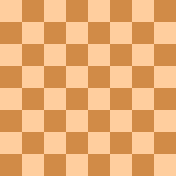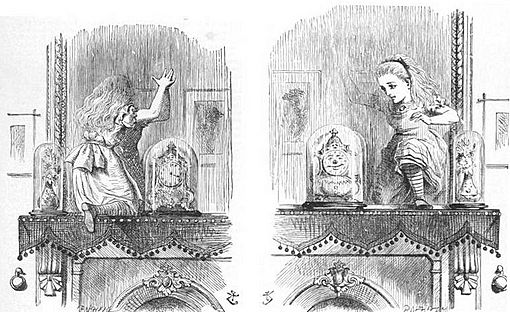Alice chess facts for kids
Alice chess is a special kind of chess variant invented in 1953 by V. R. Parton. It uses two chessboards instead of just one. It also changes the normal rules of chess a little bit.
The game is named after Alice from Lewis Carroll's book Through the Looking-Glass. In the story, Alice goes through a mirror into another world. In Alice chess, pieces move between two boards, like going through a mirror!
This simple rule can be confusing for new players. Pieces seem to "disappear" from one board and "reappear" on the other. This often leads to fun surprises and mistakes. Because of this "nothing is as it seems" feeling, Alice chess is one of Parton's most popular games.
| This article uses algebraic notation to describe chess moves. |
How to Play Alice Chess
Move Rules
Pieces move just like they do in regular chess. But there's one big difference: after a piece moves, it immediately transfers to the same square on the *other* board. This small change makes the game very different!
At the start of the game, all pieces are on board A. Board B is completely empty. When you move a piece on board A, it finishes its turn by moving to the same square on board B. If a piece is on board B and moves, it then transfers to board A.
|
|||||||||||||||||||||||||||||||||||||||||||||||||||||||||||||||||||||||||||||||||||||||||||||||||||||||||||||||||||||||||||||||||||||||
| Position after 1.Nf3 e6 2.Ne5 Bc5 | |||||||||||||||||||||||||||||||||||||||||||||||||||||||||||||||||||||||||||||||||||||||||||||||||||||||||||||||||||||||||||||||||||||||
|
|||||||||||||||||||||||||||||||||||||||||||||||||||||||||||||||||||||||||||||||||||||||||||||||||||||||||||||||||||||||||||||||||||||||
| Position after 3.Nxf7 Bg1 | |||||||||||||||||||||||||||||||||||||||||||||||||||||||||||||||||||||||||||||||||||||||||||||||||||||||||||||||||||||||||||||||||||||||
For example, imagine the first moves are 1. Nf3 e6. White's knight and Black's pawn both start on board A. After they move, they transfer to the same squares on board B. If the game continues with 2. Ne5 Bc5, the knight returns to board A and the bishop ends up on board B (see diagram).
There are two main rules for a move in Alice chess:
- The move must be a legal chess move on the board you are playing on.
- The square you transfer to on the *opposite* board must be empty.
This means you can only capture pieces on the board your piece is currently on. If a piece is on board A, it can only capture other pieces on board A. After a capture, the capturing piece still transfers to the opposite board.
For example, if the game continued 3. Nxf7, the knight transfers to board B. Now it's Black's turn. Black cannot play 3...Kxf7 or 3...Bxf2+. This is because the squares f7 and f2 are now on board A (where the knight and bishop would land), but the king and bishop are on board B. Black also cannot play 3...Qd4 because the queen cannot jump over the pawn on d7. But the move 3... Bg1 is possible (see diagram). Even though a white pawn is on f2 on board A, the bishop's move on board B is legal, and the square it transfers to (g1 on board A) is empty.
A special rule for the king: a king cannot transfer to an empty square on the opposite board if that move would put it in check. Castling is usually allowed in Alice chess. The en passant rule is usually not used, but players can agree to use it.
Quick Checkmates
In Alice chess, some checkmates can happen very quickly because of the way pieces transfer between boards.
Fool's Mate
|
|||||||||||||||||||||||||||||||||||||||||||||||||||||||||||||||||||||||||||||||||||||||||||||||||||||||||||||||||||||||||||||||||||||||
| Fool's Mate | |||||||||||||||||||||||||||||||||||||||||||||||||||||||||||||||||||||||||||||||||||||||||||||||||||||||||||||||||||||||||||||||||||||||
One way to get a Fool's Mate is: 1. e4 d5 2. Be2 dxe4? 3. Bb5# (see diagram).
At first, it might look like Black can block the check by putting a piece between White's bishop and the king (like 3...Bd7 or 3...Nc6). But any piece used to block immediately "disappears" when it transfers to board B. And Black's king cannot escape check by moving to the opposite board with 3...Kd7, because that's not a legal move on board A. So, it's checkmate!
Here are two other ways to get a Fool's Mate:
- 1. e4 d6 2. Bc4 Qxd2? 3. Bb5#
- 1. e4 e5 2. Qh5 Nf6? 3. Qxe5#
Scholar's Mate
|
|||||||||||||||||||||||||||||||||||||||||||||||||||||||||||||||||||||||||||||||||||||||||||||||||||||||||||||||||||||||||||||||||||||||
| Scholar's Mate | |||||||||||||||||||||||||||||||||||||||||||||||||||||||||||||||||||||||||||||||||||||||||||||||||||||||||||||||||||||||||||||||||||||||
Here's an example of a Scholar's Mate: 1. e4 h5 2. Be2 Rh4 3. Bxh5 Rxe4+ 4. Kf1 d5 5. Qe2? (White is threatening 6.Qb5#) 5... Bh3# (see diagram).
Another example: 1. d4 e6 2. Qd6 Be7? 3. Qe5+ Kf8 4. Bh6# (This happened in a real game in 1973!).
Example Game Summary
Alice chess games can be very exciting! Here's a quick look at a game played in 1996 between Paul Yearout (White) and George Jelliss (Black).
|
|||||||||||||||||||||||||||||||||||||||||||||||||||||||||||||||||||||||||||||||||||||||||||||||||||||||||||||||||||||||||||||||||||||||
| Position after 11.0-0-0 | |||||||||||||||||||||||||||||||||||||||||||||||||||||||||||||||||||||||||||||||||||||||||||||||||||||||||||||||||||||||||||||||||||||||
The game started with White developing pieces and Black trying to protect their pawns. A common strategy in Alice chess is to move rooks to the other board early on. White tried to make their king safer by castling, moving it to board B.
Black then tried to attack White's queen. White had to make desperate moves to save it. Black kept up the pressure, threatening checkmate. In the end, White found a way to checkmate Black's king. Black resigned, meaning they gave up because they knew they would be checkmated soon.
This game shows how confusing and tricky Alice chess can be, with pieces constantly switching boards and creating new threats!
Other Ways to Play Alice Chess
People have created different versions of Alice chess by changing the rules slightly.
Alice Chess 2
In this version, the black army starts on board B instead of board A.
Ms. Alice Chess
This version allows "zero moves." A zero move means a piece just transfers to the opposite board without actually moving to a different square. A king cannot use a zero move to escape check. This version was created by John Ishkan in 1973.
O'Donohue Chess
In O'Donohue chess, if a piece moves and the square it would transfer to on the opposite board is already taken, the piece just stays on the board it's on. It doesn't transfer. This version was created by Michael O'Donohue in 2003.
Duo Chess
| a | b | c | d | e | f | g | h | ||
| 8 |

|
8 | |||||||
| 7 | 7 | ||||||||
| 6 | 6 | ||||||||
| 5 | 5 | ||||||||
| 4 | 4 | ||||||||
| 3 | 3 | ||||||||
| 2 | 2 | ||||||||
| 1 | 1 | ||||||||
| a | b | c | d | e | f | g | h | ||
In Duo chess, Black also starts on board B. Transferring pieces to the other board is optional. Pieces that aren't pawns can make "zero moves" and can even capture pieces with these moves. A king is in check if an enemy piece is on its "zero square" (the square it would transfer to). To win, you must checkmate the king even if it tries to escape with a zero move. Jed Stone created this in 1981.
V. R. Parton also made a smaller version of Alice chess using 8x4 boards (see diagram). He also thought about playing Alice chess with three boards instead of two! In that case, players could choose between two boards when transferring pieces.
The idea of Alice chess (using two boards and transferring pieces) can be added to almost any other chess variant. For example, you could play Raumschach (a 3D chess game) using two 5x5x5 boards and the Alice chess transfer rules.
See also
 In Spanish: Ajedrez de Alicia para niños
In Spanish: Ajedrez de Alicia para niños


